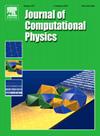High-order accurate structure-preserving finite volume schemes on adaptive moving meshes for shallow water equations: Well-balancedness and positivity
IF 3.8
2区 物理与天体物理
Q2 COMPUTER SCIENCE, INTERDISCIPLINARY APPLICATIONS
引用次数: 0
Abstract
This paper develops high-order accurate, well-balanced (WB), and positivity-preserving (PP) finite volume schemes for shallow water equations on adaptive moving structured meshes. The mesh movement poses new challenges in maintaining the WB property, which not only depends on the balance between flux gradients and source terms but is also affected by the mesh movement. To address these complexities, the WB property in curvilinear coordinates is decomposed into flux source balance and mesh movement balance. The flux source balance is achieved by suitable decomposition of the source terms, the numerical fluxes based on hydrostatic reconstruction, and appropriate discretization of the geometric conservation laws (GCLs). Concurrently, the mesh movement balance is maintained by integrating additional schemes to update the bottom topography during mesh adjustments. The proposed schemes are rigorously proven to maintain the WB property by using the discrete GCLs and these two balances. We provide rigorous analyses of the PP property under a sufficient condition enforced by a PP limiter. Due to the involvement of mesh metrics and movement, the analyses are nontrivial, while some standard techniques, such as splitting high-order schemes into convex combinations of formally first-order PP schemes, are not directly applicable. Various numerical examples validate the high-order accuracy, high efficiency, WB, and PP properties of the proposed schemes.
求助全文
约1分钟内获得全文
求助全文
来源期刊

Journal of Computational Physics
物理-计算机:跨学科应用
CiteScore
7.60
自引率
14.60%
发文量
763
审稿时长
5.8 months
期刊介绍:
Journal of Computational Physics thoroughly treats the computational aspects of physical problems, presenting techniques for the numerical solution of mathematical equations arising in all areas of physics. The journal seeks to emphasize methods that cross disciplinary boundaries.
The Journal of Computational Physics also publishes short notes of 4 pages or less (including figures, tables, and references but excluding title pages). Letters to the Editor commenting on articles already published in this Journal will also be considered. Neither notes nor letters should have an abstract.
 求助内容:
求助内容: 应助结果提醒方式:
应助结果提醒方式:


